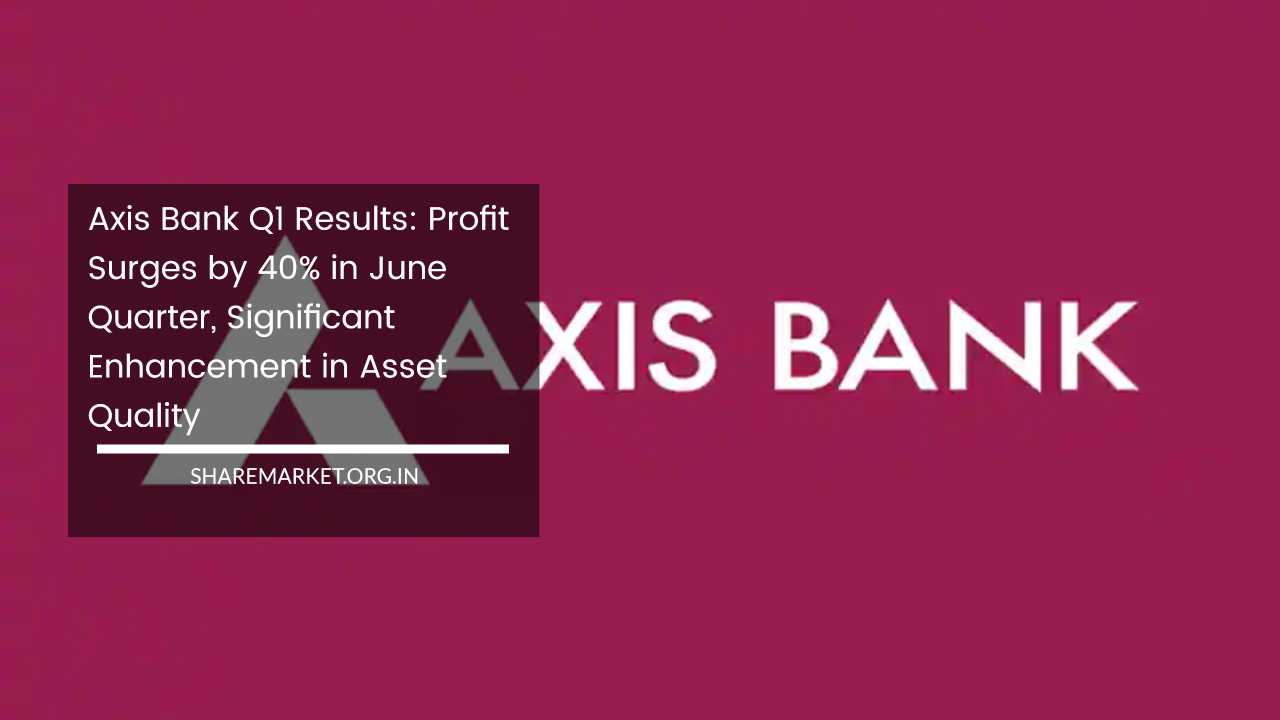Axis Bank Q1 Results: Profit Surges by 40% in June Quarter, Significant Enhancement in Asset Quality

Axis Bank Q1 Results
In the first quarter of the fiscal year 2023-2024 (FY24), Axis Bank, a private sector bank, reported its financial results:
1. Net Profit Increase: The bank’s net profit showed significant growth, rising by 40 percent to reach Rs 5,790 crore during the April-June quarter.
In the same quarter of the previous fiscal year, the bank had recorded a net profit of Rs 4,125 crore.
2. Improved Asset Quality: The bank’s asset quality demonstrated positive developments during the quarter.
This suggests that the bank’s loan portfolio had fewer non-performing assets (NPAs) or bad loans, which is a favorable sign for the bank’s financial health.
3. Underperformance Relative to Analysts’ Estimates: Despite the impressive growth in net profit and improved asset quality, Axis Bank’s overall financial performance for the quarter fell short of what financial analysts had predicted. The bank’s actual results did not meet the expectations set by market analysts.
Overall, these results indicate a positive trend for Axis Bank, with increased profits and improved asset quality.
However, the fact that the bank’s performance did not meet analysts’ estimates could lead to further scrutiny and may impact investor sentiment in the short term.
Axis Bank Q1 FY24 Results: Strong Growth in Net Profit and Improved Asset Quality
The quarterly results of Axis Bank for the first quarter of FY24 showed significant improvements across several key financial indicators:
1. Net Interest Income (NII) Growth: The bank’s Net Interest Income, which is the difference between interest earned from loans and interest paid on deposits, registered a strong growth of 27 per cent year-on-year, reaching Rs 11,959 crore.
This increase in NII indicates that the bank’s core lending and borrowing activities have been successful in generating higher interest income during the quarter.
2. Net Interest Margin (NIM) Increase: The Net Interest Margin, which represents the difference between the interest earned on assets and the interest paid on liabilities, experienced a year-on-year growth of 50 basis points, reaching 4.10 per cent in Q1FY24.
A higher NIM indicates that the bank is effectively managing its interest rate spread and optimizing its interest-earning assets to generate more profits.
3. Decline in Gross Non-Performing Assets (GNPA): The bank’s Gross Non-Performing Assets, which are loans that have stopped generating interest income due to non-payment, decreased to 1.96 per cent in Q1FY24.
This is a significant improvement compared to the previous year’s GNPA of 2.76 per cent. A lower GNPA ratio suggests that the bank’s efforts to manage and recover bad loans have been effective, leading to a healthier loan portfolio.
4. Decrease in Net Non-Performing Assets (NNPA): The Net Non-Performing Assets, which are the bad loans after provisions, also witnessed a decline to 0.41 per cent during the quarter. In the previous year, the NNPA was at 0.64 per cent.
This reduction indicates that the bank has been successful in recovering or provisioning for its bad loans, resulting in a lower impact on its overall financial health.
Overall, the quarterly results portray a positive picture for Axis Bank in Q1FY24. The bank experienced substantial growth in Net Interest Income and Net Interest Margin, indicating efficient interest rate management.
Moreover, the decline in both Gross and Net Non-Performing Assets suggests improved asset quality and better control over credit risk.
These positive developments are likely to instill confidence among investors and stakeholders in the bank’s performance and outlook for the future.
Axis Bank Q1 FY24 Results: Robust Deposit Growth and Strong Retail Lending Performance
Axis Bank reported significant growth in its total deposits during the first quarter of FY24, with a notable increase in savings and current account deposits. The specific details of the bank’s deposit growth are as follows:
1. Total Deposits: Axis Bank’s total deposits witnessed a substantial year-on-year increase of 17 per cent. This growth indicates a strong inflow of funds into the bank from various sources, such as individuals, businesses, and institutions.
2. Savings Account Deposits: Within the total deposits, there was a remarkable 22 per cent year-on-year rise in savings account deposits. Savings accounts are typically held by individuals and represent a significant portion of retail deposits.
3. Current Account Deposits: Axis Bank also experienced a notable 23 per cent year-on-year growth in current account deposits. Current accounts are primarily used by businesses and corporations for their daily banking transactions.
4. Total Term Deposits: The bank’s total term deposits, which include fixed deposits and other time-bound deposits, increased by 13 per cent year-on-year. Term deposits are an essential component of a bank’s funding and lending activities.
5. Share of CASA Deposits: The share of Current Account and Savings Account (CASA) deposits in the bank’s total deposits grew significantly, rising by 182 basis points year-on-year to reach 46 per cent. CASA deposits are crucial for banks as they generally have lower interest payout obligations, thereby improving the bank’s net interest margin.
Moving on to the bank’s advances (loans), Axis Bank also showed strong growth in this area:
6. Advances Growth: The bank’s advances, which represent the total amount of loans extended to borrowers, grew by an impressive 22 per cent to reach Rs 8.58 lakh crore.
This indicates increased lending activities and demand for credit from various sectors.
7. Domestic Loans: Within the advances, domestic loans witnessed robust growth of 26 per cent year-on-year. Domestic loans are those given to borrowers within the country, reflecting strong credit demand in the Indian market.
8. Retail Loans: The bank’s retail loan segment, which includes loans given to individuals for various purposes like home loans, personal loans, and car loans, grew by 21 per cent year-on-year, reaching Rs 4.97 lakh crore. Retail loans constituted a significant portion, accounting for 58 per cent of the bank’s net advances.
These growth figures in deposits and advances indicate that Axis Bank has been successful in attracting deposits from customers and deploying them effectively through increased lending, particularly in the retail segment.
The strong performance in both deposit and lending activities bodes well for the bank’s overall financial health and indicates positive prospects for future growth and profitability.
Axis Bank Shares Gain 1.37% on Strong Quarterly Results Announcement
On 26th July, Axis Bank’s shares performed well in the stock market, registering a gain of 1.37 per cent on that particular trading day. The closing price of the stock on the National Stock Exchange (NSE) was Rs 975.70.
The positive movement in the share price suggests that investors reacted favorably to the news of the bank’s strong quarterly results, which were announced after the market closed.
The anticipation and optimism surrounding the results likely contributed to the upward momentum in the stock price.
The gain of 1.37 per cent indicates that investors have perceived the bank’s performance in the first quarter of FY24 positively, leading to increased demand for Axis Bank shares on the trading day.
This higher demand drove the stock price higher, culminating in the closing price of Rs 975.70 on the NSE.
It’s important to note that stock prices are influenced by various factors, including the company’s financial performance, market sentiment, economic conditions, and geopolitical events.
The 1.37 per cent gain in Axis Bank’s shares on this specific trading day signifies the positive reaction of investors to the bank’s quarterly results, showcasing their confidence in the bank’s future prospects.

















